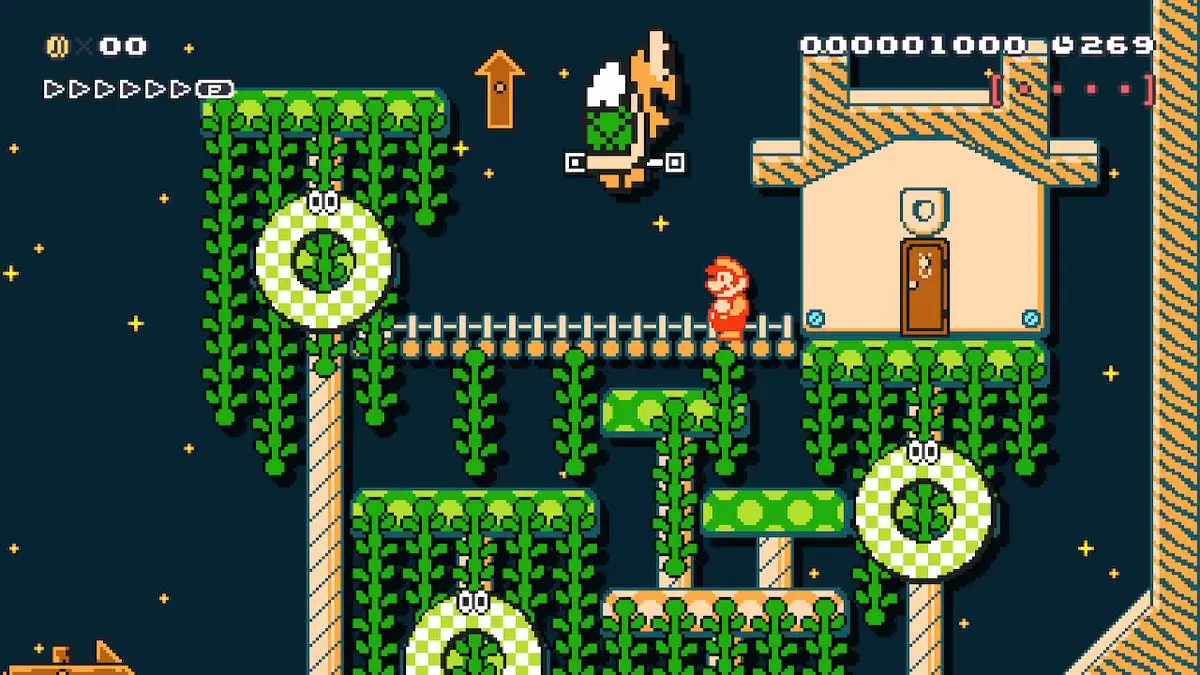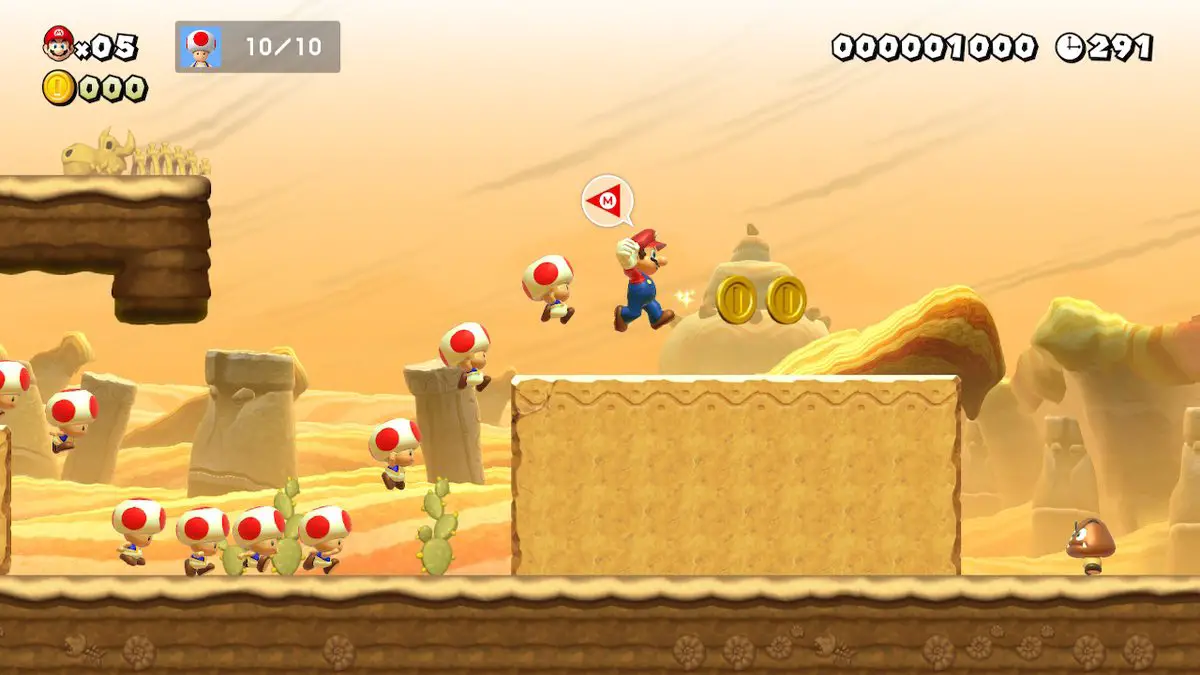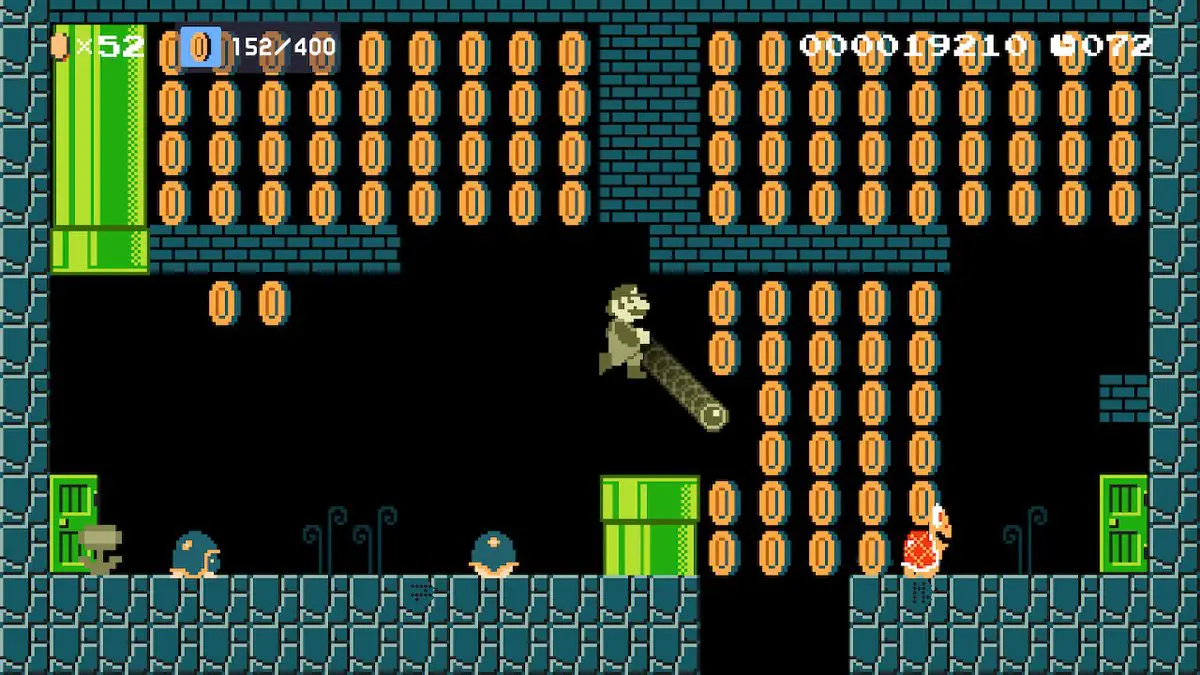
I think it’s safe to say that the Mario platforming series has quite a storied history. From the injection of Super Mario Bros. into the console scene back in 1985, Nintendo has sustained the AAA, 2D platformer for the past thirty-four years via the Mushroom Kingdom. But, in my humble opinion, the series’ punch has lost its power, as the platforming series such as Kirby, Yoshi, and Donkey Kong Country have provided more varied and interesting experiences than Mario’s simple point A to point B obstacle design. As such, I’ve largely fallen out of step with not only the New Super Mario Bros. series, but the classic 2D titles as well. I can appreciate the former for their polish and the latter for their historical significance, but their straightforward design has always prevented me from truly becoming engaged. Well, Super Mario Maker on the Wii U changed that, opening the door to a realm where 2D Mario meant more than it did before. Even still, that title felt limited in its own ways. The groundwork was set; we just needed a sequel to expound upon what made the Wii U original so tantalizing. Enter Super Mario Maker 2. While the game still carries holdover issues from the original and introduces some of its own, Super Mario Maker 2 is easily the most robust and exciting 2D Mario title of the past thirty-plus years.
The success of Super Mario Maker 2 is the manner in which it deconstructs the Mario formula and allows for creators to subvert traditional Mario expectations by building anything their minds can cook up. The Mario series has always been a vault of platforming potential confined to the narrow obstacle course design that marked the pre-Maker landscape. Even that original Maker title didn’t fully open the door, leaving many gameplay systems and tools relegated to various, core titles. Well, in Super Mario Maker 2, the doors are off the barn, and the result is a truly full toolbox of creativity. While the crux of the experience is undoubtedly the community creation aspects, and this is where said creativity shines the brightest, the game’s brand-new Story Mode likewise illustrates the strengths of Super Mario Maker 2. In this mode, Mario is tasked with the recreation of Peach’s Castle after Super Mario Maker’s infamous Undo Dog fired a reset rocket at the establishment. If that sounds hokey, that’s because it is. But, this thin setup is a non-issue as it becomes the foil for the most creative Mario campaign ever crafted.

The one hundred, Nintendo-created levels featured in Story Mode all ask something new of the player. Sometimes, this means exploring a Metroidvania-lite ghost house. Other times, this means hopping into a shmup-styled Clown Car stage. And, if you’re really lucky, you’ll get an ON-OFF block speedrun. The challenges here all feel truly diverse and interesting. I never felt like I was just traipsing through another traditional obstacle course. For once, Nintendo themselves are innovating upon the Mario formula, and I’m hard-pressed to see any justification for the company returning to a more traditional 2D Mario experience in the years to come. This mode also flexes one of the most interesting new additions to Super Mario Maker 2: clear conditions. Instead of the goal being to simply “get right,” creators can challenge the player to reach the goal under various conditions. From not taking damage or jumping, to killing a certain amount of enemies or collecting a certain amount of coins, these conditions further modify and adjust the game flow in a positive way. Nintendo’s use of these clear conditions in the Story Mode was particularly creative and much like the rest of Story Mode, inspired myself and many other creators to experiment with level gimmicks I wouldn’t have otherwise.
As previously mentioned, though, the true heart of the Super Mario Maker 2 experience lies within the truly endless amount of user-generated content. After all, the game is largely just a toolbox, giving the player the opportunity to build and share their own stages online with others. As such, the conversation in this section of the review ought to be bifurcated in the same manner that the game itself is: between “Make” and “Play.” Now, the level editor itself is largely unchanged from the original Super Mario Maker, merely streamlined–lacking much of the literal moving and shaking required to augment various level components on the Wii U. For instance, instead of having to drag a mushroom onto a Koopa to make him larger or shake a green Koopa to turn him red, holding down on a Koopa in Super Mario Maker 2 will bring up a hot bar of elements you can fiddle with. This can take some getting used to for players who were familiar with the original, but I largely prefer the straightforward design here, and newcomers to the series will immediately understand how to engage with the editor. Every level element is easily located through radial, category wheels and the gridded design allows for easy, precise drag-and-drop creation. While some touch elements can be finicky, the accessibility and snap-together design philosophy found in the level editor makes creation a breeze.

The trouble though, is the ways in which the player can interface with the editor. Frankly, any mode of control feels like a compromise from the Wii U original. Building stages in handheld mode retains much of the fluidity found in Super Mario Maker 1, but between the UI and your finger, the screen can get very busy very quickly. I have largely adjusted to the process of using the level creator at this point, but using the tools requires just that: an adjustment.Once you’ve gotten a feel for the motion of the Mario Maker ocean, though, the tools available are incredibly powerful and allow for a high degree of player agency and creative design. In fact, spending any time at all providing examples of what can be made using these tools seems counterproductive–you really can create almost anything in Super Mario Maker 2. “Almost” is the key word here, however, as there are some frustrating limitations that have made their way from Wii U to Switch. For instance, the number of doors, sub-areas, and pipes that can be placed in a level still feels low, and the new Super Mario 3D World style (which very fresh and fun to experiment with) is saddled by many of its own odd quirks such as not being able to stack enemies or swap out drivers in Koopa Cars.
That said, the myriad new tools and elements introduced in Super Mario Maker 2, from snake blocks to ON-OFF switches, open up so many new design possibilities that the game’s intrinsic limitations feel less overbearing in the face of so many fresh options. In fact, the scope and variety of player-created levels already online are testament to this. Unlike the level creator in Super Smash Bros. Ultimate, great user-content doesn’t feel inherently compromised by a lacking toolset, and a great user level can be not only on parity with what Nintendo creates, but actually superior. Between all five game styles, all eight environment themes for each style, every night mode permutation of each environment, and the countless tools available to experiment with, I don’t think Super Mario Maker 2’s level pool will ever reach a point of stagnation, there is simply so much space for imaginative design—especially considering the sequel’s addition of multiplayer. While the camera can feel inelegant at times, well designed multiplayer stages feel fulfilling and far more enjoyable in co-op or versus than the ham-fisted multiplayer of New Super Mario Bros.

Superball Coin Blitz: F3R-MBC-4JG
Of course, to share your creations and play the creations of others, you have to hop online. There are three main ways to interface with the levels of others: through playing courses individually, the endless mode, and online multiplayer in either co-op or versus. These options are all wrapped up in the online hub, Course World. On paper, these options allow for a lot of flexibility in the levels you play and the ways you play them. In practice, that flexibility is largely present, but it does fall short in terms of level discovery. Endless mode is the facet of Super Mario Maker 2’s Course World I’ve spent the most time with and is the aspect of the game that provides the purest and most streamlined Mario experience. Split into four difficulties (easy, normal, expert, and super expert) this mode throws level after level at you until you run out of lives. Considering that the levels pulled are totally random, the quality of challenges you’ll face can, let’s say, fluctuate, but the ability to skip any level with the push of the minus button mitigates any jank-related frustration. Not all level creators are equally skilled, unfortunately. That said, this is a great way to sample a variety of stages and simply flow from level to level, experiencing new concepts and stages you wouldn’t otherwise be privy to.
The online multiplayer works on a similar principle of pulling random levels, however it is a less successful mode overall than Endless. Largely, the issue arises when the game attempts to pull levels that aren’t designed for multiplayer, leading to frustrating rounds where the challenge simply doesn’t feel tailored to a group. When a level does work, though, (and when the peer-to-peer connection isn’t grinding the game’s framerate to the single-digits) there is unparalleled fun to be had. Messing with the other players and strategically adventuring through a course to be the first on the flagpole brings a new dynamic to the Mario Maker experience, which is something I can really appreciate. However, the high-volume of poor-connection players and uneven selection from the level aggregator left me feeling more mixed about the online than I had hoped to be. Eschewing such random modes, levels can also be searched for and played individually, and this is the place in which Super Mario Maker 2’s Course World is both an improvement over the original’s but not full enough a step forward to rectify the game’s largest issue: level exposure and discovery. As one would expect, these are integral aspects of the Mario Maker experience. Unfortunately, they aren’t handled as well as one would hope. Frankly, the best way to find and share stages, as with the original, is to visit some sort of external platform—Twitter being my site of choice. The tools in-game simply aren’t robust enough to facilitate the showcasing of such a high amount of user-generated content.

Olimar’s Pikmin Adventure: YMT-2GW-CGF
Sure, you can give your level a title and custom description and give it up to two rudimentary tags (including standard, speedrun, etc.), but this simply isn’t enough. Stages don’t enter the Endless aggregate until they’ve been played at least once, and the inability to utilize custom hashtags or search by keyword leads to getting your level off the ground rather difficult, unless your have connections external to the game itself. Even finding trending, popular stages can be difficult unless they’re ranked high enough to fall into the most popular levels tab, as the only way to find an individual level is through entering its nine-digit code—no title searching here. Naturally, this is a difficult problem to solve and will always face the same content discovery issues as various social media sites do, but there are ways to improve this aspect of the game. For starters, we really should have the ability to write custom hashtags as well as the ability to search by keywords instead of just codes. Those are incredibly basic features that should be in the game and would bring the chance for discovery at least to the same level as, say, a post on Twitter. Beyond that, there should be a level hopper that only pulls from unplayed or barely played stages, giving players a chance to help raise their fellow creator’s stages into the light. Perhaps this mode could see Mario wearing his explorer’s outfit from Super Mario Odyssey (Or Mario’s Picross, if you like to be technical) and awarding players with medals based on how many uncharted levels they explore. Something along these lines could better infuse new stages into the fray, which I feel is necessary.
Keep in mind, unplayed levels aren’t inherently bad, often times they’re solid stages that simply come from players who have no real way of getting eyes on their work. The game features like and dislike buttons which can help separate the good levels from the bad, and award exposure accordingly. The issue here lies within simply giving the community the chance to determine whether a level is worthy of a like or a dislike in the first place. To that effect, though, Super Mario Maker 2 does feature, alongside the like/dislike buttons, a robust comment and doodle system which can be used to communicate directly with the level creators as well as a lighthearted, Mii-based level creator profile system. These added features make the online feel rather alive and engaging, and I’ve found myself compelled to interact with other players far more than I did in the first game.
Super Mario Maker 2 isn’t a game devoid of flaws. With its various restrictions, lacking course discovery, and questionable online, there is plenty to pick apart here. That said, I’d be hard pressed to truly say that my overall experience with the game has been dampened by any of these troubles. Super Mario Maker 2 is more than just a level creator; it’s a community for Nintendo fans to come together and revel in each other’s creativity. There is such an inherent accessibility and magic to the formula that I find the experience to be defined not by its abject successes and shortcomings, but by its inherent potential. The levels already created by the community reinforce this notion tenfold, and my journey with Super Mario Maker 2 is only just beginning. Only time will illustrate the full trajectory of the experience, but I hold few reservations when I say that Super Mario Maker 2 is already one of my favorite games on the Nintendo Switch.
Super Mario Maker 2
Excellent
Super Mario Maker 2 is a game that transcends its flaws. While the game can improve in several key areas, these shortcomings are triumphantly eclipsed by the strengths of the game. From its robust and accessible suite of level creation tools to its myriad ways to play, the sheer potential for fun, subversive Mario experiences outshines any problem the game may have. Super Mario Maker 2 is more than a game, it’s a community—one I plan on spending a lot of time in.
Pros
- Nearly endless potential for creative level design
- Myriad new features including multiplayer and course tools
- Subversive and engaging story mode
- Robust online hub with different ways to interface with the community
Cons
- Some strange creation restrictions
- Shoddy online
- Lacking avenues for level discovery
